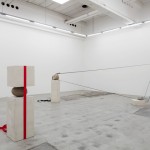El pasado 10 de octubre de 2015 inauguró en la galería Nicolai Wallner, ubicada en København V, Dinamarca, la exposición individual del mejicano A Line is Written on Every Corner. A propósito de esta muestra se publicó en la Kopenhagen Magasin la siguiente entrevista realizada por Kathrine Wallner al artista:
Can you please tell me about your exhibition at Galleri Nicolai Wallner?
The exhibition presents a series of sculptures that deal with the notion of the struggle against gravity, focusing on the nature and principles of equilibrium.
How are we supposed to understand the title A line is written on every corner?
The line has been a pivotal element through history of drawing and art, of composition and creation. Not only Kandinsky but many many others have written extensively about it. A corner, as the encounter of planes, is essential to any spatial creation. The title aims to describe the obvious. It is about space and drawing, perception and observation.
- A line is written on every corner. Galleri Nicolai Wallner, 2015
- A line is written on every corner. Galleri Nicolai Wallner, 2015
- A line is written on every corner. Galleri Nicolai Wallner, 2015
- A line is written on every corner. Galleri Nicolai Wallner, 2015
- A line is written on every corner. Galleri Nicolai Wallner, 2015
- A line is written on every corner. Galleri Nicolai Wallner, 2015
Your sculptures are created by balancing opposing objects. What effect would you say is created when balancing these objects?
A sense of tension, a sense of frozen movement, which is in itself an oxymoron. This effect aims to highlight appreciation of simple structural and functionalist principles as artistic composition and physics as poetic understanding.
How does your previous position as an architect influence your art? What do you find interesting in the sphere between architecture and art?
I did study architecture for five years and graduated from university. But I don’t consider myself as an architect at all. I worked as an architect for three years while I was a student… but never again practiced professionally. While I was studying architecture I was already doing some art shows focusing on site-specific art and urban contexts. I have been working as an artist professionally since the year of 2000 and my first ever exhibition was in 1996, which is almost 20 years ago.
However, certain notions of materiality, spatial evaluation and physical pondering seems I can’t escape from.
Can you tell me about the materials you use in your sculptures? What significance do the materials carry for you?
I use very basic materials. Marble, stone, concrete and glass. But all of them have huge significance. The stone for example, it is, literally and figuratively, the raw material of civilization. Marble was for centuries the medium for sculpture creation… while concrete and glass are the predilect materials of modernism and contemporary architecture.
- Obra reciente. Espacio Monitor, 2014
- Obra reciente. Espacio Monitor, 2014
- Obra reciente. Espacio Monitor, 2014
Do you create your work with the intention of affecting the viewer in a certain way?
I never use to think about the viewer as an entity while I’m creating a work, I tend to focus on what the work in itself needs to exist, to stand. I do think about the viewer when I’m installing the work in a certain space, becuase I want the viewer to be very aware of where he is and how the presence of the objects I work with, affects its own presence and perception.
How do you work with art history? What kind of «quotations» do you find interesting?
I’m an auto-didactical artist, I never went to art school. So my «education» comes from books and experience. It has been a natural result of my relation with books, to try to understand what I do in relation to what has been done before, a line of creation and development. I like the works of art that trigger my mind, that would be the «quotations» i find interesting. I think the sublime is when something goes beyond our control or understanding.
Thank you.
Ver / Descargar la entrevista de fuente primaria
Más información en http://www.nicolaiwallner.com/exhibitions.php?action=details&id=89









